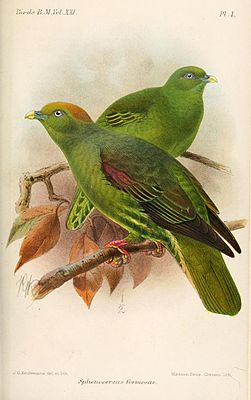Formosa green pigeon
| Formosa green pigeon | ||||||||||
|---|---|---|---|---|---|---|---|---|---|---|

Formosa green pigeon, drawing by Keulemans , 1893 |
||||||||||
| Systematics | ||||||||||
|
||||||||||
| Scientific name | ||||||||||
| Treron formosae | ||||||||||
| Swinhoe , 1863 |
The Formosa green pigeon ( Treron formosae ), also known as Taiwan green pigeon or Taiwan fruit pigeon , is a species of pigeon birds. It is distributed in several subspecies in Southeast Asia and, along with the Siebold green pigeon, is one of the green pigeons with the northernmost distribution area.
The population of the Formosa green pigeon is indicated by the IUCN as near threatened , as the population is steadily declining.
Appearance
The Formosa green pigeon reaches a body length of 33 centimeters. It is a medium-sized, compactly built pigeon that is slightly larger than a laughing pigeon . The tail accounts for between 10.2 and 12.1 centimeters. The beak is between 1.8 and 1.9 centimeters long. The gender dimorphism is low.
Appearance of the male
In the male, the wax skin of the beak is almost featherless. The front of the head and the reins are yellowish-olive in color and merge into a red-brown to orange crown and nape. The neck is matt gray-olive, the coat is dark green. The small elytra are dark red-brown, the middle ones are dark green with an individually different red-brown overlay. The large wing covers are blackish with bright yellow edges on the outer flags. The wings are blackish with a narrow pale yellow border on the outer flags. The wings of the hand are black. The back and the upper tail-coverts are dark green. The control feathers are a bit lighter and have wide black borders except for the middle pair.
The chin, throat, ear covers and chest are apple green, the belly is a little more yellow. The rump and legs are pale yellow with dark green feather shafts. The under tail-coverts are pale yellow, the longer feathers also have dark green feather shafts here.
The iris is red, the featherless orbital ring is blue, the beak and the wax skin are bright blue, the tip of the beak is grayer. The feet and legs are red.
Appearance of the females
The females resemble the males. Their forehead is dull green and the parting lacks the orange tone. The mantle and the small wing covers are dark green. The underside of the body is duller and darker green.
Possible confusion
In the distribution area of the Formosa green pigeon, the Siebold green pigeon also occurs, which also belongs to the green pigeons . The Siebold green pigeon is, however, lighter overall. The face and chest are more yellow, the belly is white to pale yellow. In both sexes, the orange tone of the parting is missing.
Distribution area
The Formosan Grüntaube comes to Taiwan, the island Lan Yu , Calayan Iceland , Camiguin Iceland and Sabtang ago. The pigeon is very rare in Taiwan. On the other islands in its range, the species is only more common in a few regions.
In Taiwan, the pigeon is found mainly in mountain forests. In other regions of the distribution area it inhabits tropical and subtropical forests and agricultural areas of the lowlands and foothills.
Way of life
The Formosa fruit pigeon mainly eats fruits and occasionally seeds. Small figs play a special role in their diet. The nest is built high in trees. It is a pigeon-typical loose platform made of small branches. The clutch consists of two white eggs.
literature
- David Gibbs, Eustace Barnes and John Cox: Pigeons and Doves - A Guide to the Pigeons and Doves of the World . Pica Press, Sussex 2001, ISBN 90-74345-26-3 .
- Gerhard Rösler: The wild pigeons of the earth - free living, keeping and breeding . M. & H. Schaper Verlag, Alfeld-Hannover 1996, ISBN 3-7944-0184-0 .
Web links
- Treron formosae in the Red List of Threatened Species of the IUCN 2012. Posted by: BirdLife International, 2012. Accessed November 13, 2016th
- Call of the Formosa green pigeon on Xeno-Canto